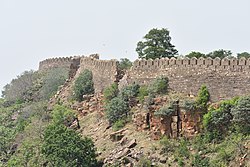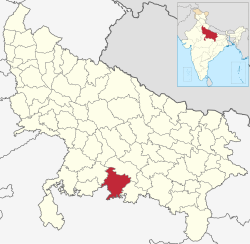District in Uttar Pradesh, India
| Banda district | |
|---|---|
| District | |
 Kalinjar Fort Kalinjar Fort | |
 Location of Banda district in Uttar Pradesh Location of Banda district in Uttar Pradesh | |
| Country | |
| State | Uttar Pradesh |
| Division | Chitrakoot |
| Headquarters | Banda |
| Government | |
| • Lok Sabha constituencies | Banda (shared with Chitrakoot district) |
| Area | |
| • Total | 4,413 km (1,704 sq mi) |
| Population | |
| • Total | 1,799,410 |
| • Density | 410/km (1,100/sq mi) |
| • Urban | 275,755 |
| Demographics | |
| • Literacy | 68.11 per cent |
| • Sex ratio | 863 |
| Time zone | UTC+05:30 (IST) |
| Website | banda |
Banda district is a district of Uttar Pradesh state of India, and Banda is the district headquarters. It is a part of Chitrakoot Division.
Located in historical Bundelkhand region, Banda is famous for its Shajar stone which is used for making jewellery, and the historically and architecturally significant sites Khajuraho and Kalinjar. Khajuraho is a World Heritage Site famous for its elaborately carved temples. The fortress of Kalinjar is famed for its war history and its glorious rock sculptures.
History
In 1998, the tehsils of Karwi and Mau, formerly part of Banda District, became the new Chitrakoot District. Banda was a town and district of British India, in the Allahabad division of the United Provinces. The population in 2011 was 1,799,410. It was formerly, but is no longer, a military cantonment.
Administrative divisions
There are five Tahsils namely Banda, Naraini, Baberu, Pailani and Atarra comprising eight blocks of Badokhar-khurd, Jaspura, Tindwari, Naraini, Mahua, Baberu, Bisanda and Kamasin from the present district of Banda.
There are seventeen thanas namely Kotwali City, Kotwali Dehat, Mataundh, Tindwari, Pailani, Chilla, Naraini, Atarra, Girwa, Kalinjar, Badousa, Bisanda, Baberu, Kamasin, Fatehganj, Jaspura and Marka.
Hills
The hills of the district consist of the part of the Vindhyan plateau which lies in the extreme southern portion of the tahsils Mau and Karwi (now known as the district Chitrakut). The northern flank of the Vindhyas known as Vindhyachal range, starts near the Yamuna in the extreme east of tahsil Mau. It recedes from the Yamuna in a south-westerly direction-gradually rising in elevation, although nowhere above 450 metre from the mean sea level. It leaves the district near the scared hills of Anusuiya to reappear of Godhrampur in the south-eastern part of Naraini tahsil. From this point westward to Kalinjar the hills from the border of the district.
Geography
The district largely consists of irregular uplands with outcrops of rocks intermingling with lowlands, which are frequently under water during the rainy season. The Baghein River traverses the district from south-west to north-east. Other important rivers are the Ken River in the east and the Yamuna to the north. The dominant communities of this area are of Kshatriyas, Patels, Chandrauls, Chandelas, Bundelas etc.
Location and boundaries
The district is located in the Chitrakutdham Division of Uttar Pradesh with its headquarter at Banda and lies between Lat. 24º 53' and 25º 55' N and Long. 80º 07' and 81º 34' E. It is bounded in the north by district of Fatehpur in the east by the district of Chitrakut in the west by the district of Hamirpur and Mahoba and in the south by Satna, Panna, and Chhatarapur the districts of adjoining Madhya Pradesh.
Agriculture
There are two main crops: Kharif and Rabi; the one between July and October and the other between November and March. The old records in the imperial gazetteer or the district gazetteer mentions cotton as one of the major crops here. But that has vanished now. The main crops grown presently are as follows:
Kharif: Paddy, jowar, bajra, til, moong, urd, arhar and sanai are the main crops taken these days. Paddy is normally taken as mono crop while others are mixed sown. 100 years ago cotton was taken as a mixed crop along with other crops in Kharif. Presently Government is pushing soybean replacing all other Kharif crops. This tendency ultimately will starve this district.
Rabi: Wheat, barley along with gram, linseed, mustard, masoor and peas are the major crops. There is a tendency for mixed cropping and regional variation in choices of the crops depending upon the geographical situation and the availability of irrigation.
Zaid: the third crops are usually taken in the river beds; that includes Kakri. Tarbooj (water melon), Kharbooja and some vegetables.
Economy
The economy is predominantly agricultural, with the main crops being paddy rice, wheat and vegetables.
In 2006 the Ministry of Panchayati Raj named Banda one of the country's 250 most backward districts (out of a total of 640). It is one of the 34 districts in Uttar Pradesh currently receiving funds from the Backward Regions Grant Fund Programme (BRGF).
Divisions
The district is divided into five tehsils, Banda, Naraini, Baberu, Atarra and Pailani.
Villages
Demographics
| Year | Pop. | ±% p.a. |
|---|---|---|
| 1901 | 406,944 | — |
| 1911 | 424,056 | +0.41% |
| 1921 | 396,194 | −0.68% |
| 1931 | 421,181 | +0.61% |
| 1941 | 486,491 | +1.45% |
| 1951 | 519,370 | +0.66% |
| 1961 | 631,666 | +1.98% |
| 1971 | 792,699 | +2.30% |
| 1981 | 1,023,644 | +2.59% |
| 1991 | 1,237,962 | +1.92% |
| 2001 | 1,501,602 | +1.95% |
| 2011 | 1,799,410 | +1.83% |
| source: | ||
| Religions in Banda district (2011) | ||||
|---|---|---|---|---|
| Religion | Percent | |||
| Hinduism | 91.00% | |||
| Islam | 8.76% | |||
| Other or not stated | 0.24% | |||
| Distribution of religions | ||||
According to the 2011 census Banda District has a population of 1,799,410, roughly equal to the nation of The Gambia or the US state of Nebraska. This gives it a ranking of 265th in India (out of a total of 640). The district has a population density of 404 inhabitants per square kilometre (1,050/sq mi). Its population growth rate over the decade 2001–2011 was 17.06%. Banda has a sex ratio of 863 females for every 1000 males, and a literacy rate of 68.11%. 15.32% of the population lives in urban areas. Scheduled Castes make up 21.55% of the population.
Languages
Languages of Banda district (2011)
Hindi (95.81%) Bundeli (1.96%) Urdu (1.50%) Others (0.73%)At the time of the 2011 Census of India, 95.81% of the population in the district spoke Hindi, 1.96% Bundeli and 1.50% Urdu as their first language. The local dialect changes from Bundeli in the south to Awadhi in the north.
Among Banda's languages are Bundeli, which has a lexical similarity of 72-91% with Hindi (compared to 60% for German and English) and is spoken by about 7,800,000 people in Bundelkhand.
Education
- Government Medical College, Banda
- Rajkiya Engineering College, Banda
- Banda University of Agriculture and Technology
Culture
Kalinjar Mahotsava: Every Year Banda District celebrates week-long Kalinjar Mahotasava to promote Kalinjar Fort's Heritage & Tourism. Kalinjar Mahotsava includes many Cultural and Social activities.
Banda MLA & MP
There are 4 assembly constituencies and 1 parliamentary constituency.
MLA
| No | Constituency | MLA | Political Party |
|---|---|---|---|
| 232 | Tindwari | Ramakesh Nishad | Bhartiya Janta Party |
| 233 | Baberu | Vishambhar Singh Yadav | Samajwadi Party |
| 234 | Naraini | Smt. Ommani Verma | Bhartiya Janta Party |
| 235 | Banda | Prakash Dwivedi | Bhartiya Janta Party |
MP
| Constituency | MP | Political Party |
|---|---|---|
| Banda | Krishna Devi Shivshanker | Samajwadi Party |
People associated with Banda
- Maharishi Vamdev
- Nasimuddin Siddiqui, Former UP cabinet minister is from Banda
- Babu Singh Kushwaha, Former UP cabinet minister is from Banda
- Daddu Prasad, Former UP minister
- Vishambhar Nishad, Former Rajya Sabha member and SP general secretary is from Banda and lives here.
Political figures
See also
Gallery
-
 Khatri Pahar temple, local tourist attraction near to Banda City
Khatri Pahar temple, local tourist attraction near to Banda City
References
- ^ Ministry of Panchayati Raj (8 September 2009). "A Note on the Backward Regions Grant Fund Programme" (PDF). National Institute of Rural Development. Archived from the original (PDF) on 5 April 2012. Retrieved 27 September 2011.
- Decadal Variation In Population Since 1901
- "Table C-01 Population by Religion: Uttar Pradesh". censusindia.gov.in. Registrar General and Census Commissioner of India. 2011.
- ^ "District Census Handbook: Banda" (PDF). censusindia.gov.in. Registrar General and Census Commissioner of India. 2011.
- US Directorate of Intelligence. "Country Comparison:Population". Archived from the original on 13 June 2007. Retrieved 1 October 2011.
Gambia, The 1,797,860 July 2011 est.
- "2010 Resident Population Data". U. S. Census Bureau. Archived from the original on 19 October 2013. Retrieved 30 September 2011.
Nebraska 1,826,341
- ^ "Table C-16 Population by Mother Tongue: Uttar Pradesh". www.censusindia.gov.in. Registrar General and Census Commissioner of India.
- ^ M. Paul Lewis, ed. (2009). "Bagheli: A language of India". Ethnologue: Languages of the World (16th ed.). Dallas, Texas: SIL International. Retrieved 28 September 2011.
- M. Paul Lewis, ed. (2009). "English". Ethnologue: Languages of the World (16th ed.). Dallas, Texas: SIL International. Retrieved 28 September 2011.
- "List of Candidates in BANDA :BANDA". myneta.info. Retrieved 11 November 2015.
External links
| Places adjacent to Banda district, India | ||||||||||||||||
|---|---|---|---|---|---|---|---|---|---|---|---|---|---|---|---|---|
| ||||||||||||||||
| Chitrakoot division topics | |
|---|---|
| General | |
| Mythology, history | |
| Districts | |
| Rivers, dams, lakes | |
| Languages, people | |
| Lok Sabha constituencies | |
| See also | |
| Other Divisions | |
25°30′N 80°30′E / 25.500°N 80.500°E / 25.500; 80.500
Categories: